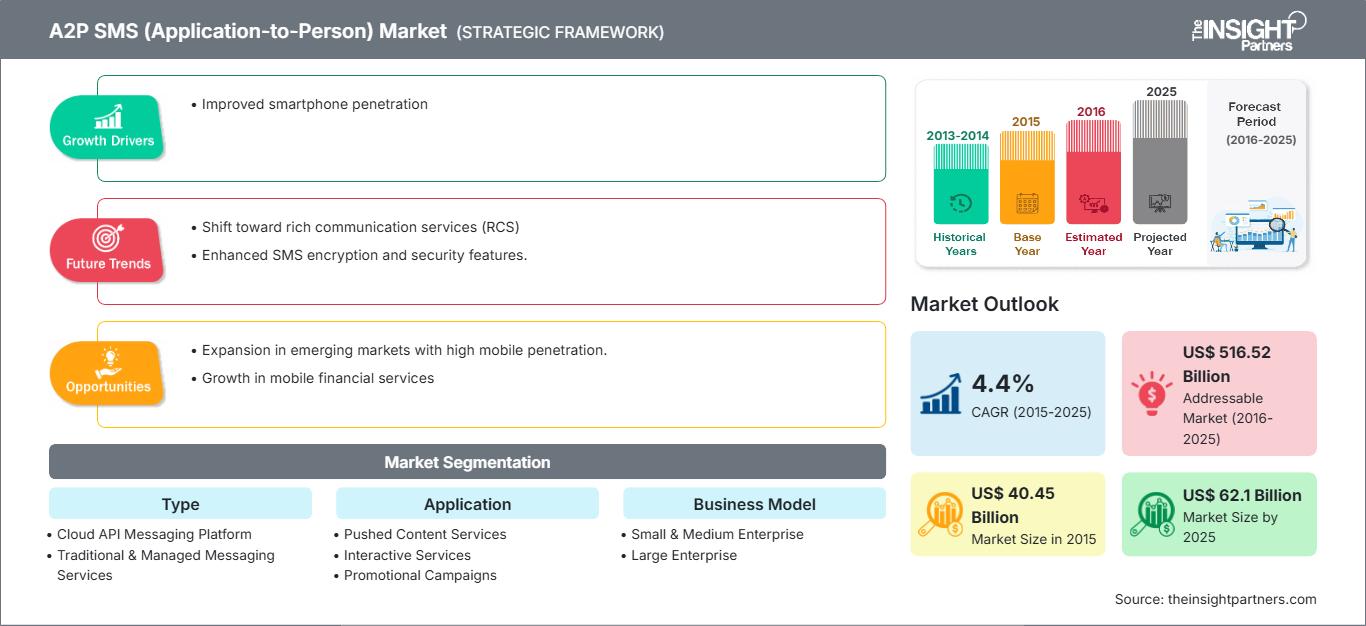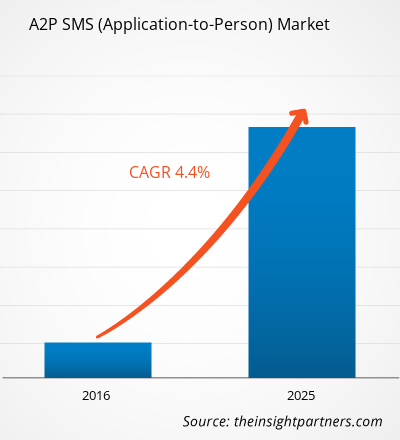Der A2P-SMS-Markt wird im Prognosezeitraum 2016–2025 voraussichtlich um durchschnittlich 4,4 % wachsen und im Jahr 2025 ein Volumen von 62,1 Milliarden US-Dollar erreichen.
A2P-SMS bezeichnet die Kommunikation zwischen einer Anwendung und einem Teilnehmer über Messaging-Dienste zu verschiedenen Zwecken. Mit der Weiterentwicklung von Smartphones und dem Aufkommen von OTT-Anbietern auf dem Markt verzeichneten die Mobilfunknetzbetreiber einen starken Rückgang ihrer Einnahmen aus P2P-Messaging-Diensten (Peer-to-Peer). Gleichzeitig stiegen jedoch die A2P-SMS-Einnahmen der Mobilfunknetzbetreiber weltweit.
Passen Sie diesen Bericht Ihren Anforderungen an
Sie erhalten kostenlos Anpassungen an jedem Bericht, einschließlich Teilen dieses Berichts oder einer Analyse auf Länderebene, eines Excel-Datenpakets sowie tolle Angebote und Rabatte für Start-ups und Universitäten.
A2P-SMS-Markt (Application-to-Person): Strategische Einblicke

- Holen Sie sich die wichtigsten Markttrends aus diesem Bericht.Dieses KOSTENLOSE Beispiel umfasst Datenanalysen, die von Markttrends bis hin zu Schätzungen und Prognosen reichen.
Sie erhalten kostenlos Anpassungen an jedem Bericht, einschließlich Teilen dieses Berichts oder einer Analyse auf Länderebene, eines Excel-Datenpakets sowie tolle Angebote und Rabatte für Start-ups und Universitäten.
A2P-SMS-Markt (Application-to-Person): Strategische Einblicke

- Holen Sie sich die wichtigsten Markttrends aus diesem Bericht.Dieses KOSTENLOSE Beispiel umfasst Datenanalysen, die von Markttrends bis hin zu Schätzungen und Prognosen reichen.
SMS erreichen Kunden selbst in den entlegensten Gebieten mit Internetverbindung und werden so zur einfachsten Art der Kundenkommunikation. Im Gegensatz zu Instant-Messaging-Diensten funktioniert der SMS-Dienst auf Standardhandys und ist nicht von einer Internetverbindung abhängig. Die Reichweite und Flexibilität von SMS-Diensten ist im Vergleich zu Online-Diensten deutlich größer, und der Vorteil, dass Prepaid-Handynutzer auch bei leerem Guthaben Textnachrichten erhalten, verschafft dieser Art von Kommunikation einen Vorteil. Zu den wichtigsten Merkmalen von Messaging gehören die höhere Leserate innerhalb von Minuten und die höchste Interaktionsrate im Vergleich zu E-Mails und OTT-Messaging-Apps. Da Kunden Nachrichten eher öffnen als E-Mails, ist es naheliegend, dass dies den A2P-SMS-Markt vorantreibt.
Berichtsumfang
In unserer Studie haben wir den A2P-SMS-Markt nach Typ, Anwendung, Geschäftsmodell und Branche segmentiert. Das Typensegment des A2P-SMS-Marktes umfasst Cloud-API-Messaging-Plattformen sowie traditionelle und Managed Messaging Services. Auf Basis der Anwendungen ist der A2P-SMS-Markt grob in Pushed Content Services, Interaktive Dienste, Werbekampagnen, CRM-Dienste und Sonstige Dienste segmentiert. Zudem ist der Markt für A2P-SMS nach Branchen mit großem Anwendungsspektrum unterteilt, darunter BFSI, Einzelhandel, Medien & Unterhaltung, Reisen & Transport, Gastgewerbe und andere Branchen mit großem Anwendungsspektrum für A2P-SMS. Geografisch ist der A2P-SMS-Markt in Nordamerika, Europa, Asien-Pazifik (APAC), Naher Osten & Afrika (MEA) und Südamerika (SAM) unterteilt. Einer der wichtigsten Faktoren für die Nachfrage nach A2P-SMS ist die weltweit steigende Zahl von Mobilfunkteilnehmern, die diese zu allgegenwärtigen Geräten für Kommunikationszwecke machen. Der BFSI-Sektor hat im letzten Jahrzehnt enorme Entwicklungen erlebt. Die Sicherheit von Verbraucherdaten und die Bedeutung von Marketingstrategien wurden als wichtigste Faktoren bei der Gestaltung von A2P-Kampagnen für alle Branchen genannt. Die Allgegenwärtigkeit von SMS-Diensten hat das Wachstum des A2P-SMS-Marktes erheblich gefördert. A2P-Nachrichten werden von Banken und Gesundheitseinrichtungen für Erinnerungen, den mobilen Ticketverkauf von Veranstaltungen, Einmalkennwörter (OTP), Flug- und Zuginformationen, Werbeaktionen und Umfragen usw. verwendet, um nur einige zu nennen. Um eine maximale Kundenreichweite zu erreichen, kann man sich nicht nur auf die Dienste von OTT-Anbietern verlassen. Die maximale Reichweite lässt sich stattdessen durch SMS-Dienste erzielen. Der Grund dafür ist, dass es weltweit in vielen Regionen immer noch Handynutzer gibt, die keine mobilen Internetdienste abonnieren. Da OTT-Anbieter in der Regel eine Internetverbindung benötigen, um die Nachrichtenübermittlung zu gewährleisten, haben Organisationen in der jüngeren Vergangenheit SMS-Dienste bevorzugt.
Regionale Einblicke in den A2P-SMS-Markt (Application-to-Person)
Die Analysten von The Insight Partners haben die regionalen Trends und Faktoren, die den A2P-SMS-Markt (Application-to-Person) im Prognosezeitraum beeinflussen, ausführlich erläutert. In diesem Abschnitt werden auch die Marktsegmente und die geografische Lage von A2P-SMS (Application-to-Person) in Nordamerika, Europa, im asiatisch-pazifischen Raum, im Nahen Osten und Afrika sowie in Süd- und Mittelamerika erläutert.
Umfang des A2P-SMS-Marktberichts (Application-to-Person)
| Berichtsattribut | Einzelheiten |
|---|---|
| Marktgröße in 2015 | US$ 40.45 Billion |
| Marktgröße nach 2025 | US$ 62.1 Billion |
| Globale CAGR (2015 - 2025) | 4.4% |
| Historische Daten | 2013-2014 |
| Prognosezeitraum | 2016-2025 |
| Abgedeckte Segmente |
By Typ
|
| Abgedeckte Regionen und Länder | Nordamerika
|
| Marktführer und wichtige Unternehmensprofile |
|
Dichte der Marktteilnehmer für A2P-SMS (Application-to-Person): Verständnis der Auswirkungen auf die Geschäftsdynamik
Der A2P-SMS-Markt (Application-to-Person) wächst rasant. Dies wird durch die steigende Endnutzernachfrage aufgrund veränderter Verbraucherpräferenzen, technologischer Fortschritte und eines stärkeren Bewusstseins für die Produktvorteile vorangetrieben. Mit der steigenden Nachfrage erweitern Unternehmen ihr Angebot, entwickeln Innovationen, um den Bedürfnissen der Verbraucher gerecht zu werden, und nutzen neue Trends, was das Marktwachstum weiter ankurbelt.

- Holen Sie sich die A2P-SMS-Markt (Application-to-Person) Übersicht der wichtigsten Akteure
- Historische Analyse (2 Jahre), Basisjahr, Prognose (7 Jahre) mit CAGR
- PEST- und SWOT-Analyse
- Marktgröße Wert/Volumen – Global, Regional, Land
- Branchen- und Wettbewerbslandschaft
- Excel-Datensatz
Aktuelle Berichte
Erfahrungsberichte
Grund zum Kauf
- Fundierte Entscheidungsfindung
- Marktdynamik verstehen
- Wettbewerbsanalyse
- Kundeneinblicke
- Marktprognosen
- Risikominimierung
- Strategische Planung
- Investitionsbegründung
- Identifizierung neuer Märkte
- Verbesserung von Marketingstrategien
- Steigerung der Betriebseffizienz
- Anpassung an regulatorische Trends




















 Kostenlose Probe anfordern für - A2P-SMS-Markt (Application-to-Person)
Kostenlose Probe anfordern für - A2P-SMS-Markt (Application-to-Person)